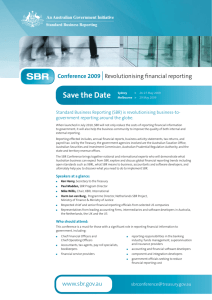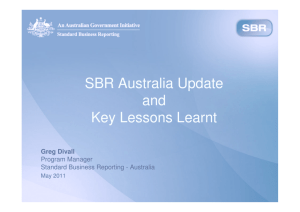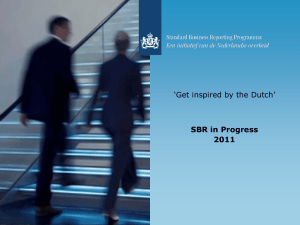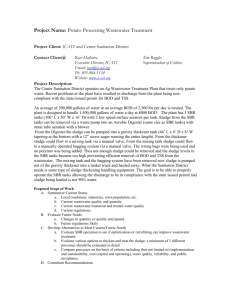comparison study between sequencing batch reactor
advertisement
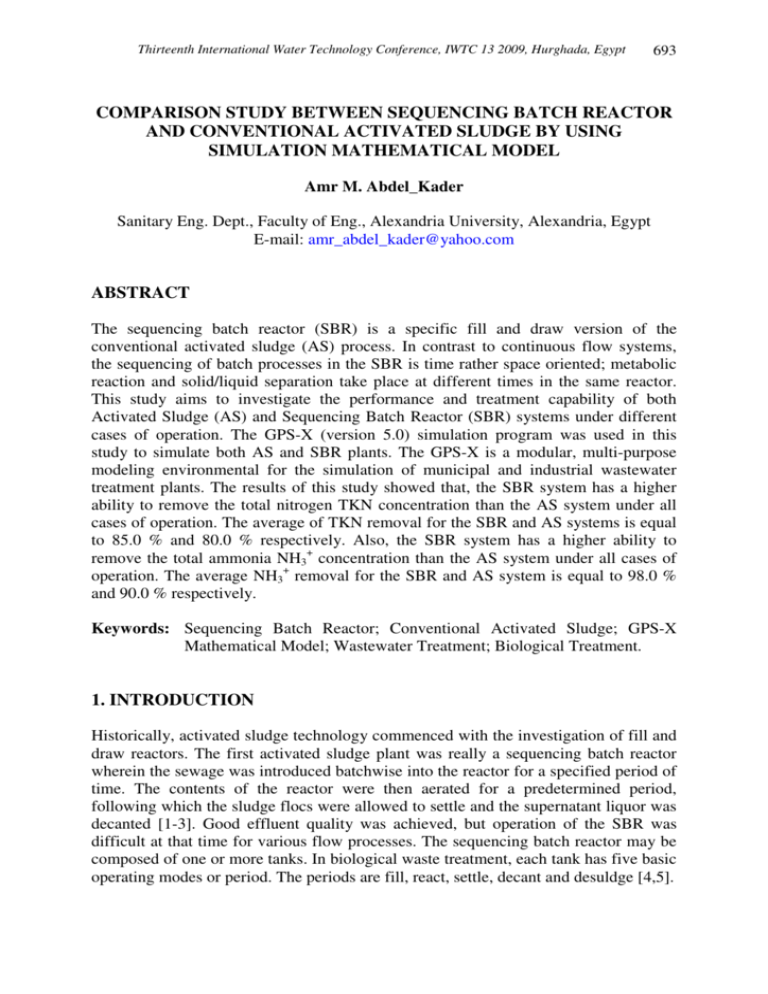
Thirteenth International Water Technology Conference, IWTC 13 2009, Hurghada, Egypt 693 COMPARISON STUDY BETWEEN SEQUENCING BATCH REACTOR AND CONVENTIONAL ACTIVATED SLUDGE BY USING SIMULATION MATHEMATICAL MODEL Amr M. Abdel_Kader Sanitary Eng. Dept., Faculty of Eng., Alexandria University, Alexandria, Egypt E-mail: amr_abdel_kader@yahoo.com ABSTRACT The sequencing batch reactor (SBR) is a specific fill and draw version of the conventional activated sludge (AS) process. In contrast to continuous flow systems, the sequencing of batch processes in the SBR is time rather space oriented; metabolic reaction and solid/liquid separation take place at different times in the same reactor. This study aims to investigate the performance and treatment capability of both Activated Sludge (AS) and Sequencing Batch Reactor (SBR) systems under different cases of operation. The GPS-X (version 5.0) simulation program was used in this study to simulate both AS and SBR plants. The GPS-X is a modular, multi-purpose modeling environmental for the simulation of municipal and industrial wastewater treatment plants. The results of this study showed that, the SBR system has a higher ability to remove the total nitrogen TKN concentration than the AS system under all cases of operation. The average of TKN removal for the SBR and AS systems is equal to 85.0 % and 80.0 % respectively. Also, the SBR system has a higher ability to remove the total ammonia NH3+ concentration than the AS system under all cases of operation. The average NH3+ removal for the SBR and AS system is equal to 98.0 % and 90.0 % respectively. Keywords: Sequencing Batch Reactor; Conventional Activated Sludge; GPS-X Mathematical Model; Wastewater Treatment; Biological Treatment. 1. INTRODUCTION Historically, activated sludge technology commenced with the investigation of fill and draw reactors. The first activated sludge plant was really a sequencing batch reactor wherein the sewage was introduced batchwise into the reactor for a specified period of time. The contents of the reactor were then aerated for a predetermined period, following which the sludge flocs were allowed to settle and the supernatant liquor was decanted [1-3]. Good effluent quality was achieved, but operation of the SBR was difficult at that time for various flow processes. The sequencing batch reactor may be composed of one or more tanks. In biological waste treatment, each tank has five basic operating modes or period. The periods are fill, react, settle, decant and desuldge [4,5]. 694 Thirteenth International Water Technology Conference, IWTC 13 2009, Hurghada, Egypt The sequencing batch reactor has many advantages by comparison with the activated sludge. The main advantages of the SBR systems are: optimization of energy through control of metabolic activity, small land requirement for the SBR, removal of nitrogen and phosphorus nutrient through proper oxygen supply management, ability of SBR system to eliminate the growth of most of the filamentous sludge bulking microorganisms by controlling the SBR cycle of operation, and ability of biological process in the SBR system to overcome hydraulic and organic shock loads problem [68]. The modular program used in this study is GPS-X (version 5.0) which is a modular, multi-purpose modeling environmental for the simulation of municipal and industrial wastewater treatment plants. GPS-X uses an advanced graphical user interface to facilitate dynamic modeling and simulation. GPS-X is also uses the most recent advances in process modeling, simulation technology, graphics and a host of productivity tools that simplify model construction, simulation and interpretation of results. 2. MATERIALS AND METHODS 2.1 Plant Configuration and Operation Conditions 2.1.1 Conventional Activated Sludge (AS) Plant The proposed Activated sludge (AS) plant are composed of two parts, first is the plug flow aeration tank unit for the biological biodegradation of the waste compounds and second is the circular secondary settling tank. Figure (1) shows the AS plant layout. The AS plant was modeled by using the GPS-X version 5.0 program. Figure 1 Conventional Activated Sludge (AS) Plant Layout. The operation conditions of the AS plant was as follows: - Total plug flow aeration tank reactors volume = 1200 m3. - Average influent flow rate = 3000 m3/d. - Return sludge flow rate = 750 m3/d (return sludge ratio 25%). Thirteenth International Water Technology Conference, IWTC 13 2009, Hurghada, Egypt 695 - Waste sludge flow rate = 60 m3/d. - Hydraulic retention time for the aeration tank (HRT) = 7.68 hr. - Mixed Liquor Suspended Solids (MLSS) = 2910 mg/l, Solid Retention Time (SRT) = 6.24 d. - For the circular settling tank: Area = 200 m2, Tank depth = 4.0 m, Tank volume = 800 m3. - Over Flow Rate (OFR) for the settling tank = 18.75 m3/m2/d. - Hydraulic retention time for the settling tank (HRT) = 5.12 hr. 2.1.2 Sequencing Batch Reactor (SBR) Plant The proposed Sequencing Batch Reactor (SBR) plant are composed of two parts, first is the sequencing batch reactor unit for the biological biodegradation and settling of the waste compounds, and second part is the equalization tank. Figure (2) shows the SBR plant layout. The SBR plant was modeled by using the GPS-X simulation program. Figure 2 Sequencing Batch Reactor (SBR) Plant Layout. The operation conditions of the SBR plant was as follows: - Number of SBR tank = 4, Total SBR tank volume = 2000 m3. - SBR tank volume = 500 m3, Area of SBR tank = 100 m2, SBR tank depth = 5.0 m. - Average influent flow rate = 3000 m3/d (125 m3/hr). - Total cycle time = 360 min (4 cycles/d). - Total fill time = 90 min (45 min mixed fill, and 45 min aerated fill). - Aeration time = 135 min. - Settling time = 55 min, Decant time = 60 min. Waste sludge time = 20 min. - Influent wastewater = 187.5 m3/cycle, Decant flow rate = 180 m3/cycle, Waste sludge flow rate = 7.5 m3/cycle. - Volumetric exchange ratio of the SBR = 37.5 %. 696 - Thirteenth International Water Technology Conference, IWTC 13 2009, Hurghada, Egypt Mixed Liquor Suspended Solids (MLSS) = 3960 mg/l. 2.2 Influent Wastewater and Model Cases of Operations The both AS and SBR plant models run by using three cases of operation. First case of operation (case 1) was run with influent BOD concentration equal to 200 mg/l. Second case of operation (case 2) was run with influent BOD concentration equal to 300 mg/l. Whereas, the third case of operation (case 3) was run with influent BOD concentration equal to 400 mg/l. The influent flow rate for all cases for both AS and SBR plant models were constant along the running time. All cases run for 8 days of operation. Influent wastewater characteristics for both AS and SBR plant showed on Table 1. Table 1 Influent wastewater characteristics for both AS and SBR plant model Parameter BOD5 for case 1, case 2, case3 Total SS Volatile SS TKN NH3 for AS and SBR plant Concentration (mg/l) 200, 300, 400 respectively 250 150 34 27.2, 32.0 respectively 3. RESULTS AND DISCUSSION 3.1 Case 1 of Operation Both the AS and SBR plant models for the case 1 of operation run for 8 days of operation with average influent BOD5 equal to 200 mg/l. The operation conditions for both AS and SBR system is similar. The start up period for both AS and SBR plants is about one day. Table 2 shows the treatment efficiency of AS and SBR plants at case 1 of operation. Figure 3 shows the relation between effluent BOD5 concentrations with time of operation for the SBR plant. Figure 4 shows the relation between the effluent TKN with time of operation for the SBR plant. The BOD removal efficiency for both AS and SBR plants is approximately the same (BOD removal for both AS and SBR systems equal to 97.5 %, 97.4 % respectively). The suspended solids removal for the AS plant is higher than the SBR plant. Whereas, the efficiency of the TKN and ammonia nitrogen NH3+ removal for the SBR plant is higher than the AS plant. The TKN removal efficiency for the AS and SBR are 83.8 % and 88.2 % respectively. The efficiency of ammonia NH3+ removal for the AS and SBR are 90.4 % and 99.0 % respectively. It can be concluded form these results that, the efficiency of nitrogen and ammonia removal for SBR system is higher than the AS system under the same operation conditions. Thirteenth International Water Technology Conference, IWTC 13 2009, Hurghada, Egypt 697 Table 2 Treatment Efficiency of AS and SBR Plants at Case 1 of operation. Parameter BOD TSS TKN NH3+ Influent AS Plant Effluent mg/l 200 250 34.0 27.2 mg/l 5.0 8.7 5.5 2.6 Removal Efficiency % 97.5 % 96.5 % 83.8 % 90.4 % Influent SBR Plant Effluent Mg/l 200 250 34.0 32.0 mg/l 5.2 16.0 4.0 0.3 Removal Efficiency % 97.4 % 93.6 % 88.2 % 99.0 % Figure 3 Relation Between Effluent BOD with Time for SBR Plant at Case 1. Figure 4 Relation Between Effluent TKN with Time for SBR Plant at Case 1. 698 Thirteenth International Water Technology Conference, IWTC 13 2009, Hurghada, Egypt 3.2 Case 2 of Operation Both the AS and SBR plant models for the case 2 of operation run for 8 days of operation with average influent BOD5 equal to 300 mg/l. The start up period for both AS and SBR plants is about one day. Table 3 shows the treatment efficiency of AS and SBR plants at case 2 of operation. Figure 5 shows the relation between effluent BOD5 concentrations with time of operation for the SBR plant. Figure 6 shows the relation between the effluent TKN with time of operation for the SBR plant. Table 3 Treatment Efficiency of AS and SBR Plants at Case 2 of operation. Parameter BOD TSS TKN NH3+ Influent AS Plant Effluent mg/l 300 250 34.0 27.2 mg/l 6.7 8.5 6.9 2.8 Removal Efficiency % 97.8 % 96.6 % 79.7 % 89.7 % Influent SBR Plant Effluent Mg/l 300 250 34.0 32.0 mg/l 6.7 16.0 5.4 0.6 Removal Efficiency % 97.8 % 93.6 % 84.1 % 98.1 % Figure 5 Relation Between Effluent BOD with Time for SBR Plant at Case 2. Thirteenth International Water Technology Conference, IWTC 13 2009, Hurghada, Egypt 699 Figure 6 Relation Between Effluent TKN with Time for SBR Plant at Case 2. The BOD removal efficiency for both AS and SBR plants is approximately the same. The suspended solids removal for the AS plant is higher than the SBR plant. Whereas, the efficiency of the TKN and ammonia nitrogen NH3+ removal for the SBR plant is higher than the AS plant. The TKN removal efficiency for the AS and SBR are 79.7 % and 84.1 % respectively. The efficiency of NH3+ removal for the AS and SBR are 89.7 % and 98.1 % respectively. It can be concluded form these results that, the efficiency of nitrogen and ammonia removal for SBR system is higher than the AS system under the same operation conditions. 3.3 Case 3 of Operation Both the AS and SBR plant models for the case 3 of operation run for 8 days of operation with average influent BOD5 equal to 400 mg/l. The start up period for both AS and SBR plants is about two days. Table 4 shows the treatment efficiency of AS and SBR plants at case 3 of operation. Figure 7 shows the relation between effluent BOD5 concentrations with time of operation for the SBR plant. Figure 8 shows the relation between the effluent TKN with time of operation for the SBR plant. The BOD removal efficiency for both AS and SBR plants is approximately the same. The suspended solids removal for the AS plant is higher than the SBR plant. Whereas, the efficiency of the TKN and ammonia nitrogen NH3+ removal for the SBR plant is higher than the AS plant. The TKN removal efficiency for the AS and SBR are 77.1 % and 82.4 % respectively. The efficiency of NH3+ removal for the AS and SBR are 89.6 % and 96.3 % respectively. 700 Thirteenth International Water Technology Conference, IWTC 13 2009, Hurghada, Egypt Table 4 Treatment Efficiency of AS and SBR Plants at Case 3 of operation. Parameter BOD TSS TKN NH3+ Influent AS Plant Effluent mg/l 400 250 34.0 27.2 mg/l 7.6 8.8 7.8 2.84 Removal Efficiency % 98.1 % 96.5 % 77.1 % 89.6 % Influent SBR Plant Effluent Mg/l 400 250 34.0 32.0 mg/l 8.5 16.0 6.0 1.2 Removal Efficiency % 97.9 % 93.6 % 82.4 % 96.3 % Figure 7 Relation Between Effluent BOD with Time for SBR Plant at Case 3. Figure 8 Relation Between Effluent TKN with Time for SBR Plant at Case 3. Thirteenth International Water Technology Conference, IWTC 13 2009, Hurghada, Egypt 701 Table 5 shows the summary of results for both AS and SBR systems for all cases of operation. It can be concluded form these results that, under all cases of operation, the efficiency of nitrogen and ammonia removal for SBR system is higher than the AS system under the same operation conditions. Also, the efficiency of BOD removal for both AS and SBR system is similar. But the efficiency of suspended solid removal for the AS system is higher than the SBR system. Table 5 Summary of results for both AS and SBR systems for case 1, case 2 and case 3. Parameter BOD removal TSS removal TKN removal NH3+ removal AS Case 1 SBR AS 97.5 % 97.4 % 96.5 % Case 2 Case 3 SBR AS SBR 97.8 % 97.8 % 98.1 % 97.9 % 93.6 % 96.6 % 93.6 % 96.5 % 93.6 % 83.8 % 88.2 % 79.7 % 84.1 % 77.1 % 82.4 % 90.4 % 99.0 % 89.7 % 98.1 % 89.6 % 96.3 % 4. CONCLUSIONS Based on the observation and results obtained from this study, the following points are concluded: - The treatment efficiency of the AS and SBR systems based on BOD removal is similar during the all cases of operation (the BOD removal ranged between 97.4 % and 98.1 % for both systems). - The AS system has a higher ability to remove the suspended solids than the SBR system during all cases of operation (the TSS removal for AS and SBR systems 96.5 % and 93.6 % respectively). - The SBR system has a higher ability to remove the total nitrogen TKN concentration than the AS system under all cases of operation (the TKN removal for SBR system ranged from 82.4 % to 88.2 %, and for AS system ranged from 77.1 % to 83.8 %). - The SBR system has a higher ability to remove the total ammonia NH3+ concentration than the AS system under all cases of operation (the NH3+ removal for SBR system ranged from 96.3 % to 99.0 %, and for AS system ranged from 89.6 % to 90.4 %). 702 Thirteenth International Water Technology Conference, IWTC 13 2009, Hurghada, Egypt REFERENCES [1] Artan N., Wilderer P., Morgenroth E. and Ozgur N. ‘The mechanism and design of sequencing batch reactor systems for nutrient removal – the state of the art’ Water Science and Technology’ Vol. 38, pp. 53-60, 2000. [2] Ketchum L. H., ‘Design and physical features of sequencing batch reactors’ Water Science and Technology’ Vol. 35, pp 11-18, 1997. [3] Morgenroth E. and Wilderer P. A. ‘Sequencing batch reactor technology: concepts, design and experiences’ J. CIWEM, Vol. 12(10), 2000. [4] Novak L., Goronszy M. C. and Wanner J. ‘ Dynamic mathematical modeling of sequencing batch reactors with aerated and mixed filling period’ Water Science and Technology’ Vol. 35, pp. 105-112, 1997. [5] Wilderer P. A., Irvine R. L. and Goronszy M. C. ‘Sequencing batch reactor technology’ scientific and technical report No. 10, IAW publishing, 2001. [6] Blackburne R., Yuan Z. and Keller J. ‘Demonstration of nitrogen removal via nitrite in a sequencing batch reactor treating domestic wastewater’ Water Research, Vol. 42, pp. 2166-2176, 2008. [7] Coelho M., Russo C. and Araujo O. ‘Optimization of sequencing batch reactor for biological nitrogen removal’ Water Research, Vol. 34, pp. 2809-2817, 2000. [8] Mikosz J., Ptaza E. and Kurbiel J. ‘Use of computer simulation for cycle length adjustment in sequencing batch reactor’ Water Sci. Tech., Vol. 38, pp. 60-76, 2000.
